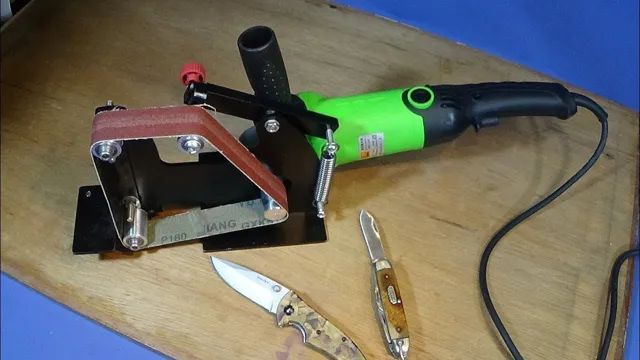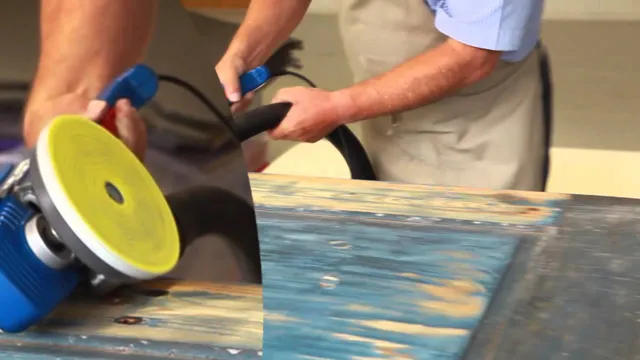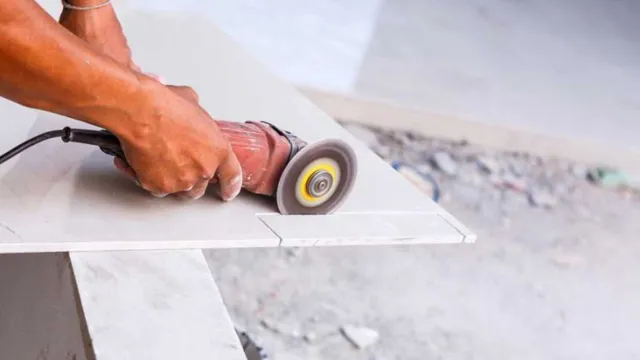Can You Use an Angle Grinder as a Sander? Pros and Cons Explained.

Angle grinders are typically associated with heavy-duty tasks, such as grinding or cutting metal. However, did you know that they can also be used for more delicate tasks, such as sanding? That’s right! You can turn your angle grinder into a versatile tool with just a few adjustments. If you’re wondering how to do this, look no further.
In this blog post, we’ll dive into the topic of using an angle grinder as a sander and discover just how easy it really is. From choosing the right attachments to avoiding common mistakes, we’ve got you covered. So grab your angle grinder and let’s get started!
Can It Be Done?
When it comes to DIY projects, it’s always useful to have tools that can serve multiple purposes. One such tool that often comes to mind is an angle grinder. But can you use an angle grinder as a sander? The answer is yes, but with the right accessories and precautions.
By attaching a sanding disc to the angle grinder and selecting the appropriate grit, you can use it to sand and smooth down rough surfaces, edges, and contours. However, it’s important to keep in mind that an angle grinder operates at high speeds and can be dangerous if not used correctly. Always wear protective gear and make sure to secure the workpiece before starting.
Additionally, make sure to practice on scrap material or in a safe environment before using an angle grinder as a sander on a larger project. So, if you’re in a pinch and need to use an angle grinder as a sander, it’s definitely possible with the right accessories and safety measures in place.
Understanding the Differences Between Angle Grinders and Sanders
Angle grinders and sanders are two of the most commonly used power tools in the world of DIY and professional work. These tools have unique differences that make them useful for different types of tasks. For example, an angle grinder is used for cutting, grinding, and polishing materials, while a sander is used for smoothing and finishing surfaces.
One of the biggest differences between the two tools is the way they operate. An angle grinder uses a rotating disc or wheel to cut or grind materials, while a sander uses a rotating sanding pad to smooth out surfaces. Despite their differences, both tools are incredibly useful and can help you complete a wide range of tasks quickly and efficiently.
So whether you are a DIY enthusiast or a professional tradesman, understanding the differences between these tools can help you choose the right one for your next project.

Potential Risks Involved in Using an Angle Grinder as a Sander
Using an angle grinder as a sander may seem like a quick fix, but it can come with a host of potential risks. While it is technically possible to use an angle grinder to sand, it is not recommended due to the high risk of injury. Angle grinders are built for cutting and grinding tasks and are not designed to handle the delicate and precise work that sanding requires.
The high-speed rotation of the angle grinder can create heat and friction, making it more likely to damage the wood surface or cause the sandpaper to become clogged and melt onto the surface. Additionally, using an angle grinder without proper safety precautions, such as wearing eye protection and a dust mask, can cause serious harm to the user. In conclusion, while using an angle grinder as a sander may seem like a cost-effective solution, it is not worth the potential risks.
It is best to use a proper sander designed for sanding tasks.
How to Convert Your Angle Grinder into a Sander
Yes, you can definitely use an angle grinder as a sander with the right attachments. Angle grinders are mainly used for cutting, grinding, and polishing metal, but can also be used for sanding wood, plastic and other materials. To convert your angle grinder into a sander, you will need to purchase a sanding disc that fits your angle grinder.
These discs come in a variety of grits, so you can choose the right one for your project. Once you have the sanding disc, attach it to your angle grinder and you’re ready to start sanding. Make sure to wear protective gear and work in a well-ventilated area to avoid inhaling dust.
Sanding with an angle grinder can be more aggressive than sanding with a regular sander, so be careful not to take off too much material too quickly. With practice, using an angle grinder as a sander can be a great way to save money and get your sanding done quickly and efficiently.
Gathering the Necessary Tools and Materials
Converting your angle grinder into a sander can save you a lot of money and effort in the long run. The good news is that all you need are a few tools and materials that you probably already have in your toolbox. Firstly, you will need an angle grinder with a compatible sanding disc.
Next, you will need a backup pad that fits the sanding disc, which is usually sold separately. Make sure the pad is rated for sanding as it needs to withstand the high speed and pressure of the grinder. Additionally, you will need a hook and loop fastening disc which is softer and cushioned which will help in giving a smooth finish.
Lastly, get some sandpapers which are of the appropriate grit suitable for the project you intend to work on. Remember to use caution when converting your angle grinder and wear protective gear such as goggles, ear protection, and a dust mask. By following these steps, you can now convert your angle grinder into a high-powered sander for your woodworking projects with ease.
Installing the Sanding Disc
If you’re thinking about converting your angle grinder into a sander, the first step is to install the sanding disc. It may seem daunting at first, but with the right tools and technique, it’s actually quite straightforward. First and foremost, you want to make sure you have the correct size sanding disc for your angle grinder.
Once you have that sorted, you’ll need to remove the existing disc and any attachments from your grinder. From there, you can install the sanding disc by lining up the holes on the disc with the spindle on your grinder and securing it in place with a nut or washer. It’s important to make sure the disc is tightly secured to avoid any accidents or mishaps while sanding.
With the disc installed, you’re ready to start sanding away. With a good quality sanding disc and a steady hand, you can achieve professional-grade results on a wide variety of surfaces. So, what are you waiting for? Give your angle grinder a new lease on life and start sanding today!
Adjusting the Speed of Your Angle Grinder
If you have an angle grinder, did you know that you can convert it into a sander? This is a great DIY hack if you can’t afford to purchase a separate sander and don’t want to spend money on renting one. To start, you need to adjust the speed of your angle grinder to make it suitable for sanding tasks. The first step is to remove the attachment on the end of the angle grinder and replace it with a sanding pad attachment.
Next, adjust the speed settings to a lower RPM range. This will prevent the sanding pad from spinning too quickly and avoid damaging the workpiece. Additionally, make sure to use the right sandpaper grit for the type of material you’re sanding to avoid any scratches or damages.
With these simple steps, you can turn your angle grinder into a versatile tool for sanding wood, metal, or even plastics. It’s a cost-effective solution that will save you time and money, while also providing professional results. So, why not give it a try and see how easy it is to get the results you desire with an angle grinder?
Tips for Effective Sanding with an Angle Grinder
“Yes, you can use an angle grinder as a sander. It’s a versatile tool that can handle a lot of different tasks, including sanding. However, using an angle grinder as a sander takes a bit of finesse to get the desired results.
One of the most effective tips for sanding with an angle grinder is to use a sanding disc instead of a grinding disc. This will allow you to reduce the speed of the tool and apply even pressure to the surface you’re sanding. Another tip is to use a coarse grit sanding disc, especially for rough surfaces.
Start with a coarse grit and gradually work your way up to a fine grit for a smooth finish. Don’t forget to wear protective gear like goggles and a dust mask to keep yourself safe from flying debris. With these tips in mind, you can effectively use an angle grinder as a sander for a variety of sanding projects.
“
Using the Right Sanding Discs
As you prepare to sand down your latest project, it’s important to understand the role that sanding discs play in achieving a smooth finish. When using an angle grinder, it’s essential to choose the right sanding disc for the job. For example, heavy-duty sanding discs are best for removing layers of paint or rust from metal surfaces, while lighter grit discs are better for smoothing out wood and plastic.
It’s also crucial to consider the size of the grit when selecting your disc. Finer grits, like 120 or 150, are ideal for creating a polished finish, while coarser grits, like 40 or 60, are better for removing large materials. Ultimately, choosing the right sanding disc is crucial to achieving professional-level results, so take the time to research your options and invest in a high-quality product that matches your specific sanding needs.
Controlling Your Angle Grinder
When it comes to sanding with an angle grinder, controlling the speed and angle of the tool can make all the difference in achieving a smooth finish. To start, make sure you are using the appropriate grit sanding disc for the task at hand. Begin by grinding at a low speed and gradually increase as needed.
Keep a firm grip on the tool and maintain a consistent angle as you work. If you’re having trouble keeping a steady hand, consider using a guide or simply resting your forearm on a stable surface. Pay attention to the direction of the sanding disc rotation and always move the grinder in the opposite direction for a more controlled sanding motion.
It’s also important to periodically check the disc for wear and replace it as needed to maintain maximum effectiveness. With these tips in mind, you’ll be on your way to achieving a professional-looking finish with your angle grinder in no time.
Conclusion: Should You Use an Angle Grinder as a Sander?
In conclusion, while an angle grinder may be able to work as a sander in some cases, it is like using a hammer to drive screws. Yes, it may be possible, but it’s not the intended use, and you’ll likely end up with a less than perfect result. So, save yourself some time and frustration, and invest in the proper tool for the job – your projects will thank you for it!”
FAQs
How does an angle grinder compare to a sander?
While an angle grinder and sander both remove material, angle grinders are typically used for heavy-duty tasks like cutting and grinding metal, while sanders are used for smoothing and polishing surfaces.
Can you attach a sanding disc to an angle grinder?
Yes, it is possible to attach sanding discs to an angle grinder. However, it is important to make sure the sanding disc is compatible with the grinder and the task you are performing.
What types of sanding discs are best for angle grinders?
The best sanding discs for angle grinders depend on the task at hand. Some of the most common types include flap discs, stripping discs, and sanding discs with various grit levels.
Is sanding with an angle grinder safe?
Sanding with an angle grinder can be safe as long as proper precautions are taken. Make sure to wear eye and ear protection, use the appropriate sanding disc, and hold the grinder firmly with both hands.
Can an angle grinder be used for woodworking?
While angle grinders can be used for woodworking, they are not the most common tool for this task. Sanders are typically better suited for woodworking tasks that require precision and care.
What is the difference between a belt sander and an angle grinder?
Belt sanders and angle grinders are similar in that they both remove material, but belt sanders are typically used for surface preparation and finishing, while angle grinders are more versatile and can handle a wider range of tasks.
How do you convert an angle grinder into a sander?
While some angle grinders may have attachments available to convert them into sanders, it is typically not recommended to use an angle grinder as a sander without the proper equipment and training. It is generally safer and more effective to use a dedicated sander for sanding tasks.



